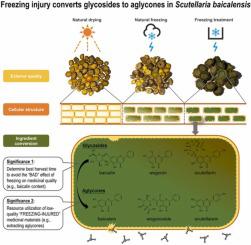Industrial Crops and Products ( IF 5.6 ) Pub Date : 2023-05-26 , DOI: 10.1016/j.indcrop.2023.116915 Meng Zhang , Bo Cao , Lingyu Che , Lianjin Liu , Yiyang Su , Xiaofang Zhou , Yumeng Lu , Guishuang Li , Chengke Bai

|
Appropriate post-harvest processing plays a critical role in the exterior quality and the yield of bioactive ingredients of medicinal crops. However, fresh medicinal materials harvested in winter often suffer from freezing injury, leading to poor quality and instability of clinical efficacy in practical production. Revealing the responses of freezing injury in medicinal crops will significantly prevent economic losses for farmers and potential risks for clinical medication. In this study, we comprehensively analyzed the effect of post-harvest freezing injury on a well-known traditional Chinese medicine, Scutellaria baicalensis (Huangqin), that harvested in late autumn or early winter in China. The exterior quality and eight active ingredients of medicinal materials processed by natural drying (ND), natural freezing (NF) and simulated freezing treatments (FT) with different treating time (T0 to T5) of S. baicalensis were analyzed and compared by high performance liquid chromatography (HPLC). The results showed that fresh roots under NF and FT treatments exhibited loose texture and green or even dark brown color, and the unique smell of S. baicalensis medicinal materials nearly disappeared. Compared with the contents of baicalin (152.48 mg/g), wogonoside (27.16 mg/g), and scutellarin (5.55 mg/g) in T0 under FT treatment, those contents in T5 significantly decreased (92.60 mg/g, 10.30 mg/g, and 0.25 mg/g, respectively) with increasing repeated freezing and thawing time. Interestingly, freezing injury dramatically improved the contents of baicalein (from 2.97 mg/g to 29.58 mg/g), wogonin (from 0.31 mg/g to 6.96 mg/g), scutellarein (from 0.96 mg/g to 1.75 mg/g), apigenin (from 0.03 mg/g to 0.07 mg/g), and chrysin (from 0.01 mg/g to 0.80 mg/g). The content of eight medicinal active ingredients and the content of glycosides under FT for 72 h (FT-72) treatment (138.98 mg/g, 102.59 mg/g) were significantly lower than those under ND treatment (189.30 mg/g, 184.58 mg/g), but that of aglycones significantly increased about eight times (36.39 mg/g for FT-72 and 4.07 mg/g for ND). Furthermore, there were significant negative correlations between the contents of baicalin and baicalein (r2 = 0.9499, P < 0.0001), wogonoside and wogonin (r2 = 0.9190, P < 0.0001), and scutellarin and scutellarein (r2 = 0.4344, P < 0.001) under FT-72 treatment. The extracting rate of active ingredients under NF treatment increased rapidly and reached almost 100% within 30 min, but that under ND treatment increased slowly and reached 100% for 50 min. It is speculated that repeated freezing and thawing destroyed cellular structures of fresh roots and strongly accelerated extracting rate of active ingredients. Subsequent ion outflow and enzyme activation led to oxidative hydrolysis that induced the transformation from glycosides to aglycones. Collectively, the above results would provide valuable guidance for medicinal farmers to avoid freezing injury in post-harvest processing, thereby ensuring medicinal quality of S. baicalensis for pharmaceutical industry. Furthermore, these results will shed light on revealing the effect and mechanism of freezing injury on product quality and help formulating technical specifications for standardized production of medicinal crops.











































 京公网安备 11010802027423号
京公网安备 11010802027423号